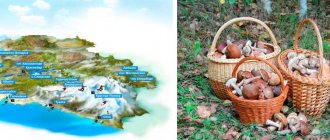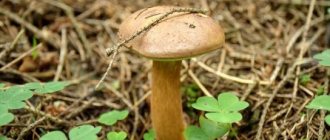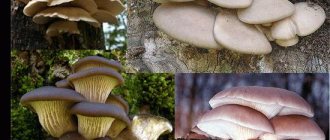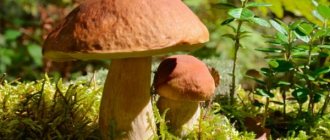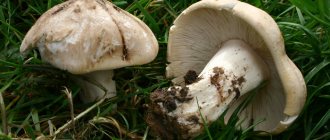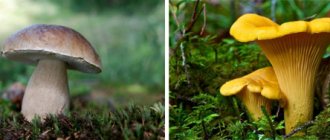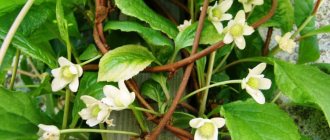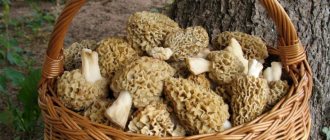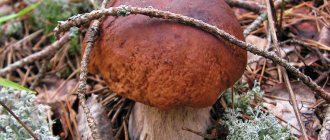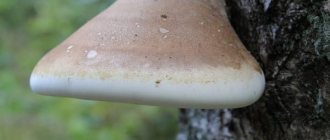Description of mushrooms
Mushroom pickers begin collecting spring mushrooms in May and finish in late October, and under current favorable weather conditions - in November. Before going into the forest, it is important for a beginner to take time to carefully study the description of the characteristics and types of forest mushrooms.
Often for this purpose they use a directory of mushrooms of the Stavropol Territory, which helps to correctly understand which mushrooms are edible and which are poisonous.
The general division occurs into 4 categories according to edibility:
- Category 1: edible;
- Category 2: conditionally edible;
- Category 3: inedible;
- Category 4: poisonous.
This classification was developed during the Soviet Union and is based on the safe consumption of mushrooms:
- Edible species may be suitable for a raw food diet.
- Conditionally edible, although safe for the body, have low taste qualities. Before cooking and eating, they are pre-soaked and then boiled or fried.
- Inedible ones will not cause harm; they are not used in cooking due to their unpleasant taste, difficulty of preparation and weak aroma.
- Poisonous ones, such as fly agarics, require special preparation for use as food. It is not possible to remove toxins from them in a simple way at home. The presence of natural toxins in the pulp as a result of eating fly agaric mushrooms leads to death.
Taste characteristics
Based on their taste value, in general, edible and conditionally edible mushrooms are also divided into 4 categories:
- Category 1: tasty and aromatic (varieties of white milk mushrooms), the best types in consumer and culinary terms.
- Category 2: good mushrooms, but they are worse in taste than the representatives of category 1 (volnushki, boletus and boletus mushrooms).
- Category 3: taste of average quality and low aroma (honey mushrooms, mushrooms, morels, etc.), this is the so-called. not the most valuable species in the consumer and culinary sense, inferior to representatives of categories 1 and 2.
- Category 4: species acceptable to taste, classified as conditionally edible (oyster mushrooms, blackberries, cobwebs, dung beetles, etc.)
Severe poisoning can occur if dishes with wild mushrooms of the 4th category are incorrectly prepared. It is important to approach the process with full responsibility, carefully sort through the harvest, rinse it several times in running water and cook strictly according to the recipe.
Inedible and poisonous mushrooms of Kuban
Walking through the forest in search of tasty forest gifts, a novice mushroom picker may come across fruits that are unsuitable for consumption due to an unpleasant taste and smell, or because they contain poisons and toxins. Fruits to stay away from in the forest are:
- Death cap. This is one of the most dangerous poisonous mushrooms in Russia. It is found everywhere - in gardens, plantings, forests, parks, meadows. The fruit can be recognized by its greenish color, the presence of a vulva and a ring on the stem.
- Entoloma is poisonous. A large mushroom, the diameter of the cap can reach 16 cm. The cap is yellow-white or grayish in color, and the flesh has a pronounced floury smell.
- Red fly agaric. The inedible mushroom is familiar to many mushroom pickers - both experienced and beginners. It has a red outstretched cap with white flakes on the surface. The leg is thin, high, ringed. Fortunately, this specimen is rare in the Kuban, mainly in mountainous areas.
In the forests of Kuban you can stumble upon false doubles of mushrooms suitable for consumption. They are not always dangerous to health, but they have an unpleasant odor and disgusting taste. Therefore, the main advice of experienced mushroom pickers is to refuse to collect unfamiliar fruits, even if they look very attractive in appearance.
Types of mushrooms of the Stavropol Territory
The Caucasus is rich in forests and forest treasures. A variety of berries and mushrooms grow on its territory, which come out to be picked with the onset of spring warmth, after rain, when the air temperature reaches +16...+17°C and the humidity is 75-80%.
Edible species
The Caucasus is rich in a variety of mushrooms
Edible wild mushrooms can also be grown in basements. So-called “mushroom farms” produce crops year-round. But there is not much benefit from this harvest, because... For a full-fledged specimen, a natural environment is required.
Names of forest edible mushrooms:
- forest champignons;
- blue leg;
- row;
- honey mushrooms;
- flywheels;
- boletus;
- boletus;
- chanterelles;
- saffron milk caps;
- Russula.
A stable and sustainable harvest of edible species has been observed in the region for many years. Some species are found within the regional center.
Poisonous and inedible
In addition to the obviously poisonous inhabitants of the forest, there is a risk of being poisoned by duplicates of edible and edible noble forest organisms, which are easily confused with the edible “originals” and put in a common basket. Their names:
- false chanterelle;
- the honey fungus is false;
- satanic mushroom;
- pale grebe.
Irina Selyutina (Biologist):
The satanic mushroom is often called a “false porcini mushroom” in various sources (both printed and electronic). They started doing this not too long ago. However, you can confuse the porcini mushroom with the satanic mushroom, also known as the satanic mushroom, only with a quick glance and from afar. This is especially true for novice mushroom pickers who have memorized the “face and profile” of white mushrooms and parts of other valuable edible mushrooms, but everything else has not yet been stored in their memory. Often, what has not yet been assimilated and has not found its “shelf” in memory causes confusion in the head. Therefore, you need to carefully and slowly examine the color of the entire fruiting body. You will see that the satanic mushroom is characterized by many red flowers and, first of all, its hymenophore has a red color. There are also many red tones in the color of the leg.
By the way. The specific epithet "satanas" for the satanic mushroom (Rubroboletus satanas) was proposed by the German mycologist Harald Othmar Lenz (1798-1870) after he himself was poisoned by this mushroom.
The false chanterelle is also characterized by differences from the real chanterelle, and with a careful, even one-time examination and comparison of these two mushrooms, you will clearly remember them forever. But with honey mushrooms and toadstools things are somewhat more complicated. There are a lot of known species of honey mushrooms, and experienced mushroom pickers recommend collecting only young specimens that have the whole range of distinctive features. They say about the pale toadstool that it skillfully disguises itself as mushrooms. In order not to bring it or another poisonous mushroom belonging to the same family, carefully examine the base of the mushroom stem without tearing it off. If you see a well-defined thickening resembling a tuber and around it there are peculiar scraps of white tissue, partially immersed in the soil, walk without stopping - in front of you are a poisonous mushroom.
Where do mushrooms grow in Adygea?
Collecting mushrooms in a mountain forest is interesting and not easy. This is an extreme sport. On the slopes of the Adygean mountains, classic porcini mushrooms often grow between the trees. They grow profusely, and if you collect a basket, clinging to stones and crawling up, with difficulty catching your balance, and suddenly accidentally let it go - that’s it, the basket will roll down, and you can start all over again. But the excitement kicks in as soon as you see the first mushroom, and without thinking about anything, you start crawling along the slopes, dreaming of finding the next one. In wetlands near streams there are usually few mushrooms. They grow on a bed of fallen leaves rather than in moss.
Collection routes
The main forest harvesting route lies in Kavminvody. This mountainous area is simply teeming with boletus, chanterelles, honey mushrooms and russula. Even black milk mushrooms and boletuses are especially lucky.
Boletuses are found in the state natural reserve of regional significance “Russian Forest”. It is not difficult for experienced mushroom pickers to find boletus and porcini mushrooms in Verbovaya, Lipovaya and Vishnevaya beams.
Irina Selyutina (Biologist):
I think many people have come across the concept of “reserve” and the root of the word is clear. But why are nature reserves created?
Sanctuary: a territory or water area in which certain species of animals, plants, or part of a natural-territorial complex are protected for several years in certain seasons or year-round. The use of other biological objects in this territory is permitted only to the extent that it does not harm the protected objects.
Even amateur mushroom pickers return from the Taman Forest with a good catch of saffron milk caps, row mushrooms and honey mushrooms.
Good places for collecting mushrooms are the Stavropol Upland and the village of Beshpagir. Forest champignons, honey mushrooms, chanterelles, russula and puffballs are found here. With one “approach” it is possible to harvest a large harvest and make supplies for the winter.
In the floodplain forests of the Kochubeevsky district, many mushrooms and bluepods are found in mushroom places.
Mushrooms from the Red Book
On the territory of the Stavropol region there are 7 species of mushrooms listed in the Red Book of this region and 4 of them were listed in the Red Book of the Russian Federation in 2008:
- Varnished tinder fungus: inedible, protected on the territory of the Russian Forest natural reserve. Serves as a raw material for the production of biologically active substances, an object of cultivation in Southeast Asia.
- Arched starwort: an inedible, protected species that lives in the territory of the Russian Forest natural reserve.
- Grifola curly, ram mushroom: edible, is a protected species on the territory of the landscape natural monument “Mount Beshtau”.
- Cereal mushroom: the population of this edible species is found and protected on the territory of the “Mount Beshtau” landscape natural monument.
Beneficial features
The content of a large number of microelements and fiber in the fruiting bodies of edible mushrooms has been confirmed by modern science. The amount of protein contained in them is several times greater than that contained in animal and poultry meat. Because of this, mushrooms received another name - “forest meat”.
Mushrooms consist of 90% water, with virtually zero fat content, and therefore have a low calorie content, making them a possible addition to various types of diets for those seeking to lose weight. The composition contains 18 amino acids. They contain vitamins A, D, E, group B and nicotinic acid, which contribute to the overall strengthening of the body.
Regular consumption of mushrooms has anticancer and antitumor effects. Natural immunostimulation occurs due to a specific substance beta-glucan, which is part of the mushrooms.
Harmful properties
The delicacy is not a dietary product: it is difficult to digest. The food is heavy and should not be eaten haphazardly by those who have gastrointestinal problems. The digestion process slows down in the stomach and intestines. Chitin, which is mostly found in the legs of autumn species, when prepared incorrectly, triggers the process of rotting in the gastrointestinal tract.
In the environment, in the soil, there may be toxins that are completely absorbed by the vegetative body of mushrooms - the mycelium, especially those growing near busy roads. After improper preparation without soaking and thorough washing in several waters and canning of mushrooms, under favorable conditions, the active development of the causative agent of botulism begins in jars.
